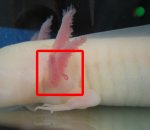HitmanSougo13
Member
- Joined
- Aug 11, 2008
- Messages
- 281
- Reaction score
- 7
Hi guys,
I've been noticing my axies seems to have about 3 strangely longer and redder filaments. I've highlighted them in the photos. They are definitely connected to his head so just so you don't think it's a worm or something. But they seem to have a different shape from the rest. I figured it may been the result of him always been scared and stressed when I have to take him out for a water change.
I know I've been progressively more and more careful with taking them out since back then I used a net and that's how his little red long loopy filament started. Discovered he was hurt from the net, I began to take him out using my hands, making sure I don't squeeze him. Yet, is it okay for him to have these long red things? I personally have this awkward feeling about them. Sometimes they appear redder but when he is scared, it turns pretty pale. Is there a suggestion I could do to help him reduce those long red filaments in size?
Thank you everyone in advance always!
I've been noticing my axies seems to have about 3 strangely longer and redder filaments. I've highlighted them in the photos. They are definitely connected to his head so just so you don't think it's a worm or something. But they seem to have a different shape from the rest. I figured it may been the result of him always been scared and stressed when I have to take him out for a water change.
I know I've been progressively more and more careful with taking them out since back then I used a net and that's how his little red long loopy filament started. Discovered he was hurt from the net, I began to take him out using my hands, making sure I don't squeeze him. Yet, is it okay for him to have these long red things? I personally have this awkward feeling about them. Sometimes they appear redder but when he is scared, it turns pretty pale. Is there a suggestion I could do to help him reduce those long red filaments in size?
Thank you everyone in advance always!



